
Crawford County is a county in the Commonwealth of Pennsylvania. As of the 2020 census, the population was 83,938. Its county seat is Meadville. The county was created on March 12, 1800, from part of Allegheny County and named for Colonel William Crawford. The county is part of the Northwest Pennsylvania region of the state.

Titusville is a city in the far eastern corner of Crawford County, Pennsylvania, United States. The population was 5,262 at the 2020 census. Titusville is known as the birthplace of the American oil industry and for a number of years was the leading oil-producing region in the world. It was also notable for its lumber industry, including 17 sawmills, as well as its plastic and toolmaking industries. It is part of the Meadville micropolitan area.
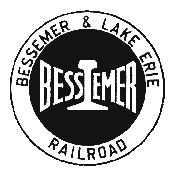
The Bessemer and Lake Erie Railroad was a class II railroad that operates in northwestern Pennsylvania and northeastern Ohio.
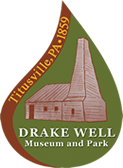
The Drake Well Museum and Park is a museum in Cherrytree Township, Pennsylvania that chronicles the birth of the American oil industry in 1859 by Colonel Edwin Drake. The museum collects and preserves related artifacts. The reconstructed Drake Well demonstrates the first practical use of salt drilling techniques for the extraction of petroleum through an oil well.

The Buffalo and Pittsburgh Railroad is a Class II railroad operating in New York and Pennsylvania.

Union Railroad is a Class III switching railroad located in Allegheny County in Western Pennsylvania. The company is owned by Transtar, Inc., which is a subsidiary of Fortress Transportation and Infrastructure Investors, after being acquired from U.S. Steel in 2021. The railroad's primary customers are the three plants of the USS Mon Valley Works, the USS Edgar Thomson Steel Works, the USS Irvin Plant and the USS Clairton Coke Works.
The Dunkirk, Allegheny Valley and Pittsburgh Railroad is a historic railroad company that operated in Pennsylvania and New York.

Pithole, or Pithole City, is a ghost town in Cornplanter Township, Venango County, Pennsylvania, United States, about 6 miles (9.7 km) from Oil Creek State Park and the Drake Well Museum, the site of the first commercial oil well in the United States. Pithole's sudden growth and equally rapid decline, as well as its status as a "proving ground" of sorts for the burgeoning petroleum industry, made it one of the most famous of oil boomtowns.

Oil Creek State Park is a Pennsylvania state park on 6,250 acres (2,529 ha) in Cherrytree, Cornplanter and Oil Creek Townships, Venango County, Pennsylvania in the United States. The park is adjacent to Drake Well Museum, the site of the first successful commercial oil well in the United States, that was drilled under the direction of Colonel Edwin Drake. Oil Creek State Park follows Oil Creek, between Titusville and Oil City, and is on Pennsylvania Route 8. While the creek is the park's main recreational attraction, it also contains the sites of the first oil boomtown and much of Pennsylvania's original oil industry. The park contains a museum, tableaux, and trails to help visitors understand the history of the oil industry there, and an excursion train.
The Jersey Shore, Pine Creek and Buffalo Railway was a railroad built in the early 1880s to give the New York Central and Hudson River Railroad access to the coal regions around Clearfield, Pennsylvania, United States.

The Allegheny Valley Railroad is a class III railroad that operates in Western Pennsylvania, and is owned by Carload Express, Inc.

The Western New York and Pennsylvania Railroad is a short-line railroad that operates freight trains in Western New York and Northwest Pennsylvania. The company is controlled by the Livonia, Avon and Lakeville Railroad, with which it does not connect. It started operations in 2001 on the Southern Tier Extension, a former Erie Railroad line between Hornell, New York and Corry, Pennsylvania, owned by the public Chautauqua, Cattaraugus, Allegany and Steuben Southern Tier Extension Railroad Authority (STERA).
The Oil Creek and Allegheny River Railway was an American railroad company that was located in western Pennsylvania.
The Williamsport and North Branch Railroad was a short line that operated in north-central Pennsylvania between 1872 and 1937. After a long struggle to finance its construction, it was completed in 1893. It derived most of its freight revenue from logging and to a certain extent from anthracite coal traffic. It also carried many passengers to mountain resorts in Sullivan County, Pennsylvania. With the decline of the logging industry and increased accessibility of the region by automobile in the 1910s and 1920s, the railroad's business rapidly declined. The economic blow of the Great Depression proved insurmountable, and it was abandoned as unprofitable in 1937.

Petroleum Center is a populated place and ghost town in Cornplanter Township, Venango County, Pennsylvania, United States. In the 19th century, the name was also spelled "Petroleum Centre". The town today is almost deserted.
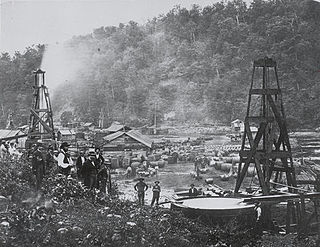
The oil rush in America started in Titusville, Pennsylvania, in the Oil Creek Valley when Edwin L. Drake struck "rock oil" there in 1859. Titusville and other towns on the shores of Oil Creek expanded rapidly as oil wells and refineries shot up across the region. Oil quickly became one of the most valuable commodities in the United States and railroads expanded into Western Pennsylvania to ship petroleum to the rest of the country.

The Oil Creek and Titusville Railroad is a tourist railroad that runs from Titusville to Rynd Farm north of Oil City in the U.S. state of Pennsylvania. The Oil Creek and Titusville Lines is the designated operator of the railroad, as well as the freight carrier on the line.
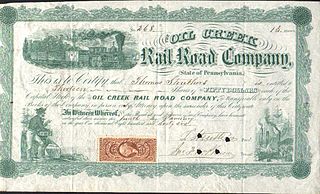
The Oil Creek Railroad Company (OCRR) was a railroad in western Pennsylvania.
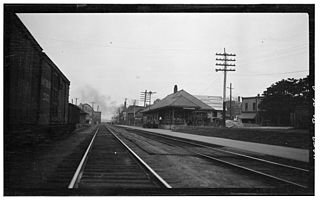
Cambridge Springs was a railroad station for the Erie Railroad in Cambridge Springs, Crawford County, Pennsylvania, United States. Cambridge Springs station was on the Main Line's Meadville Division, which was the section of the line between Salamanca, New York, and Meadville, Pennsylvania. The station was located 501.2 miles (806.6 km) from Manhattan and the Barclay Street Ferry, which connected to Pavonia Terminal in Jersey City, New Jersey, and 480.8 miles (773.8 km) from Hoboken Terminal in Hoboken, New Jersey. For nearly three decades, the station had connections to the Northwestern Pennsylvania Railway, which was a trolley line that connected the city of Erie and Meadville. Modern Erie Railroad station signage denoted the station as "Home of Alliance College," a local private university that closed in 1987.
The Pithole Valley Railway was an ephemeral short line railroad in Venango County, Pennsylvania, constructed as a result of the Pennsylvania oil rush. The railroad was originally constructed in 1865 between Oil City, Pennsylvania, a local oil transportation hub, and the boomtown of Pithole, Pennsylvania. Constructed under the charter of the Clarion Land and Improvement Company, it was informally known as the Oil City and Pithole Branch Railroad. Although it was generally supported by the broad gauge Atlantic and Great Western Railway, it was built to standard gauge. Conflict with the Warren and Franklin Railway over the right-of-way along the Allegheny River led to a lawsuit which, in 1866, declared that the Oil City and Pithole had no right to operate along the river from Oleopolis, Pennsylvania to Oil City. That part of the line was sold to the Warren and Franklin, leaving the Oil City and Pithole with a 7-mile (10 km) line running north from Oleopolis to Pithole along Pithole Creek.